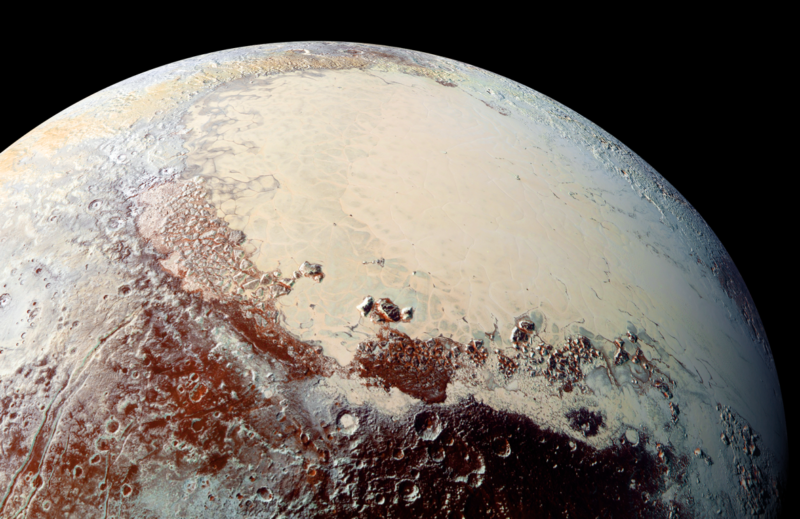New model challenges idea that Pluto started out frozen

Pluto’s recategorization as a dwarf planet may have caused some past anger, but there has never been a better time to be a Pluto fan. Since the New Horizons mission gave us our first real look at Pluto in 2015, researchers have been digging into the rich reality of this icy world. The latest question under the magnifying glass: what was Pluto like at its birth?
Beneath its surface—composed of frozen water, nitrogen, carbon monoxide, and more—Pluto is today thought to have a liquid water ocean surrounding a rocky core. But scientists are trying to figure out how long it has been that way. In the “cold start” model, Pluto’s interior ocean is thought to have been frozen but then gradually thawed due to heat from radioactive decay in the core. But it remains possible that a “hot start” model is more accurate, one where the planet started out warm enough to form some liquid water.
Cold start vs. hot start
Although the dwarf planet’s beginnings are buried deep in the past, its two possible origins should have left marks on the surface.
The key is to think about the fact that water expands when it freezes and contracts when it melts. Just as the skin of a balloon stretches when inflated, Pluto’s exterior would have to contract or expand as its interior melted or froze. A cold start with an initially frozen interior “ocean” would cause contraction as it thawed, generating compression along the surface. But after a while, the heat provided by radioactive decay in the core would diminish enough that the loss of heat to space would win out, causing the interior ocean to start freezing again. That would result in expansion, causing extension along Pluto’s surface.
A “hot start”, on the other hand, would see a liquid interior ocean from the start. There would be a rapid phase of cooling and freezing early on, generating extension on the surface. Then the radioactive-decay heating from the core and cooling from the surface would come closer to balance, greatly slowing the freezing rate for the rest of Pluto’s lifetime but still continuing the surface extension.

So by analyzing the visible faults on Pluto’s surface and noting how they’ve moved, it should be possible to differentiate between compression-then-extension and extension-only versions of Pluto’s history. UC Santa Cruz’s Carver Bierson and Francis Nimmo, along with New Horizons lead Alan Stern, put this idea to the test using what we’ve learned about Pluto’s geology.
As it happens, the researchers say there’s no evidence of compression to be seen. There are, however, relatively recent extension faults, which often produce a sunken valley between pairs of faults. So perhaps the “hot start” model is closer to reality than the more popular “cold start” hypothesis.
Fast assembly required
There’s also a very old-looking topographical feature that may represent some extension. Although there isn’t a complete and rigorous estimate of the amount of extension recorded by all these faults, the researchers’ rough calculation is compatible with their “hot start” model for Pluto’s history.
There are, theoretically, ways that the available evidence could be misleading. Faults that form under compression can reverse direction under extension later, for one. And it’s possible that impact events (particularly the one that formed Pluto’s moon Charon) and other surface processes could have erased or hidden evidence of compression. Still, all the observable geology seems to point to the “hot start” explanation.
How is it that an icy world in the outer reaches of the Solar System starts out warm, you ask? It has to do with the assembly of Pluto from the smaller pieces swirling around during the formation of the Solar System. As pieces were pulled in by gravitational attraction, energy was converted to heat on impact. So as long as Pluto assembled quickly enough to gain that heat faster than it shed heat to space, its interior could reach high temperatures.
The researchers ran the numbers and found that assembly times of around 30,000 years would definitely hit the required temperatures—though if Pluto formed from bigger chunks (which collect heat more efficiently), that number could stretch to a few million years.
Some of the models used to simulate the processes that assembled our Solar System take considerably longer than that, but some newer models can put a Pluto together quickly enough. The requirement of rapid assembly is, at the least, not a problem for the “hot start” idea.
The researchers suggest another way to test their hypothesis further, though: a much better estimate of the amount of extension Pluto’s surface has undergone would make it clearer which model is the winner.
Nature Geoscience, 2020. DOI: 10.1038/s41561-020-0595-0 (About DOIs).
https://arstechnica.com/?p=1685506